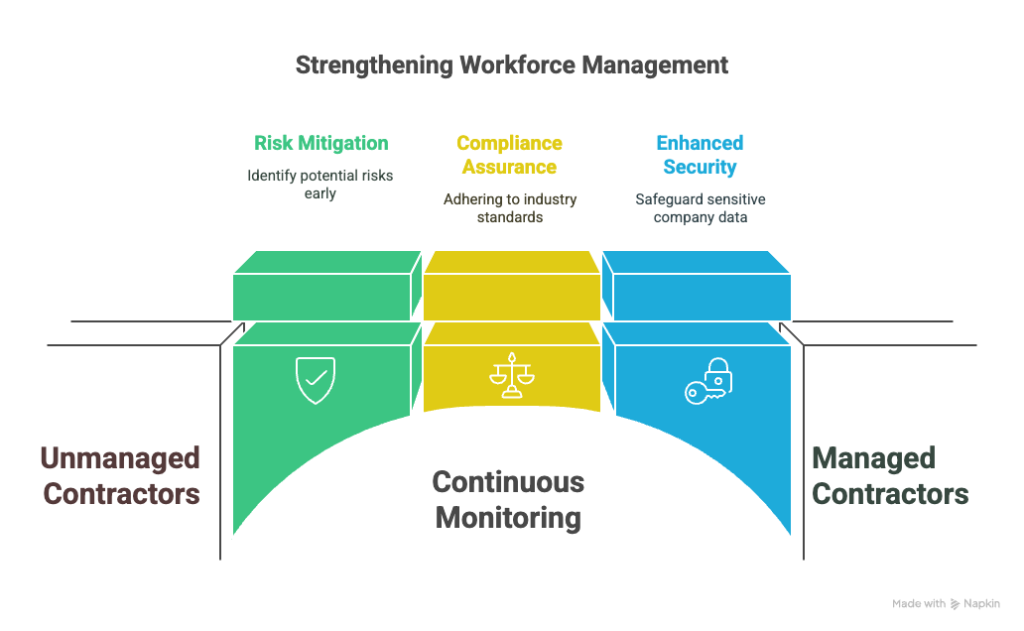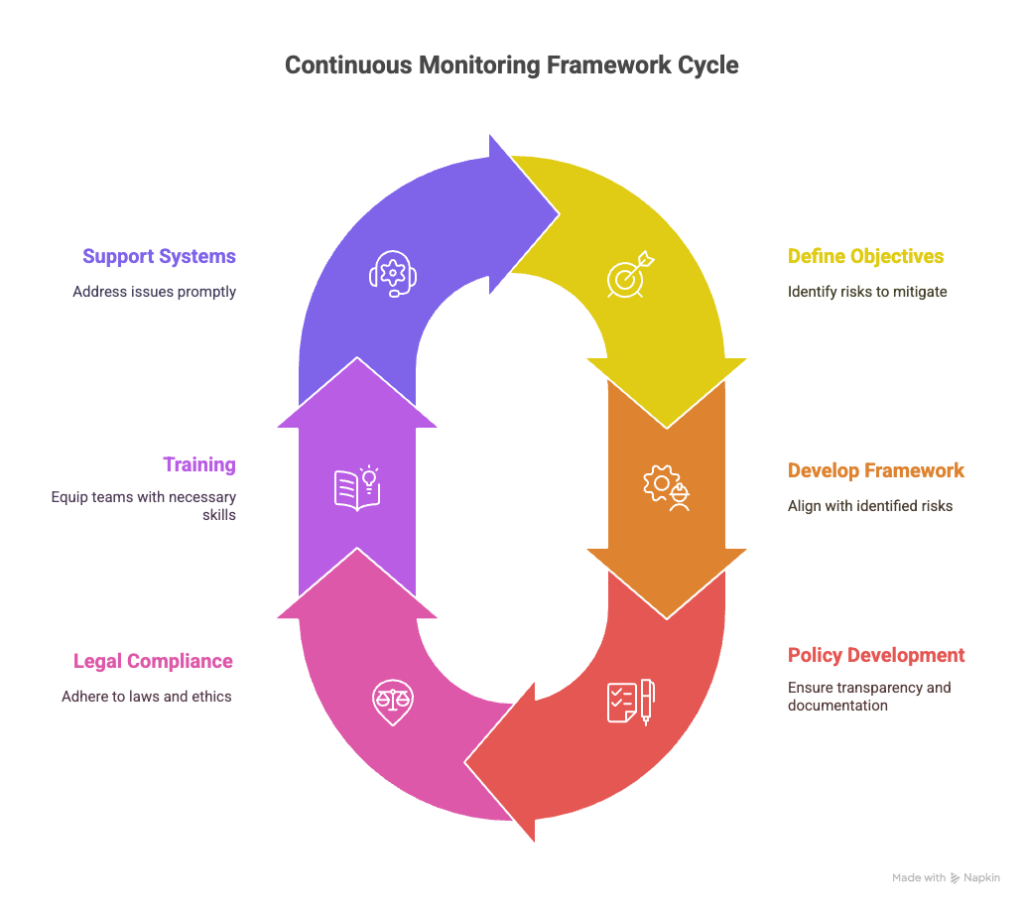In today's fast-paced business environment, the workforce landscape is rapidly evolving, emphasizing the need for innovative solutions to manage risk and ensure compliance. For organizations reliant on contractors, continuous monitoring has become a critical component of workforce management. This process not only helps mitigate risks associated with contractor engagements but also supports ongoing compliance and security within organizations.
This guide explores the concept of continuous monitoring in the context of staffing, providing insights into its benefits, implementation strategies, and the challenges it presents. Whether you're an HR professional, a hiring manager, or someone interested in workforce solutions, this comprehensive overview will equip you with the knowledge needed to oversee a contingent workforce effectively.
Key Takeaways
- Continuous monitoring helps you manage risks, ensure compliance, and enhance security in a contractor-heavy workforce.
- It involves post-hire screenings and real-time data analysis to keep your team aligned with company standards.
- Implementing effective monitoring requires clear objectives, policy development, and training for HR teams and managers.
- You must balance data privacy with monitoring needs by complying with privacy laws and using techniques like data anonymization.
- As technology and regulations evolve, stay prepared by embracing advancements like machine learning and blockchain in your monitoring strategies.
Introduction
Continuous monitoring in staffing is about keeping an eye on the workforce after hiring. It's not just for full-time employees; contractors and freelancers fall under this umbrella too. This approach ensures that you have up-to-date information about your workforce, helping you manage risks and stay compliant with industry standards.
With the increase in gig economy roles, the contingent workforce is growing fast. More organizations now rely on contractors for flexibility and specialized skills. But this shift brings its own set of challenges. How do you ensure these temporary team members adhere to your company's values and requirements? Continuous monitoring can be a part of your answer.
This guide is designed to equip you with insights on implementing robust monitoring systems. You'll learn the practical steps to set up these systems, the benefits they bring, and how to handle potential hurdles along the way. Whether you manage a handful of freelancers or a large pool of contractors, understanding continuous monitoring is crucial to keeping your operations smooth.
Why Continuous Monitoring is Crucial
Continuous monitoring is vital for any organization that relies on contractors. It serves three main purposes: mitigating risk, ensuring compliance, and enhancing security. These elements work together to strengthen workforce management in meaningful ways.
Risk is always present when employing contractors. Some contractors might engage in fraud or misconduct, while others could inadvertently cause security breaches. Continuous monitoring helps identify these potential risks early. By using regular checks and real-time data, you can detect red flags before they escalate. An example is tracking changes in a contractor’s legal status, which might affect their eligibility to work.
Compliance is more than just a checkbox. It involves adhering to industry standards and regulations consistently. Continuous monitoring ensures that contractors maintain compliance throughout their engagement. For example, if industry standards change, a monitoring system can alert you to update your practices accordingly.
Security is a major concern with the increasing digitization of business operations. Contractors often have access to sensitive company data and systems. Continuous monitoring helps to safeguard these assets by providing regular updates on any access or changes made by contractors. If a security breach occurs, you’ll have a detailed record to help resolve the issue swiftly.

Are you leveraging the best tools for monitoring? Is your team informed about compliance needs? These are crucial questions that demand your attention as you navigate contractor management. Gaps in monitoring could expose your company to avoidable risks, but continuous oversight offers a preventative measure.
Key Components of an Effective Monitoring Strategy
Understanding the essential elements of a successful monitoring strategy is crucial for maintaining the integrity and security of your workforce. Here’s a breakdown of the key components.
Post-Hire Background Screening: While initial background checks are critical, continuing the screening process after hiring helps ensure ongoing compliance and integrity. After all, a lot can change after the hiring process. Employees might face legal issues or their certifications might lapse. By conducting regular post-hire screenings, you keep your workforce reliable and up-to-date with company standards.
Ongoing Screening Processes: Implementing tools and techniques for regular screenings enhances trust and reliability. For example, monthly criminal checks or quarterly credit assessments can uncover potential risks that might affect your organization. These ongoing checks ensure your contractors remain in line with your company’s expectations and compliance requirements.
Real-Time Data Analysis: Incorporating real-time data analysis into risk monitoring allows for quick action when issues arise. For instance, instant alerts on any negative changes in a contractor’s status can help you address problems before they escalate. This dynamic approach minimizes potential disruptions and keeps your operations running smoothly.
Technology and Tools: Leveraging technology is essential for efficient monitoring. Tools like automated tracking systems or AI-driven analytics platforms streamline the process, offering faster and more accurate insights. Choose platforms that integrate well with your existing HR systems for seamless data flow and easier management. Embracing these technologies ensures you stay ahead in workforce monitoring and contractor management.
By integrating these components, you can create a robust and proactive monitoring strategy that safeguards your organization against potential risks while ensuring compliance and efficiency.
Implementing Continuous Monitoring for Contractors
Building a continuous monitoring framework starts with clear objectives. Determine what risks you aim to mitigate. Is it fraud, compliance, or data security? Once you've pinpointed your goals, develop a framework that aligns with those concerns.

Policy development is fundamental. Make sure your policies are transparent and documented. Contractors should know what is monitored and why. This transparency builds trust and sets expectations right from the start.
Legal and ethical considerations are next. Compliance with existing laws, such as GDPR or FCRA, is crucial. You must balance the need to monitor with the right to privacy. Seek legal guidance to ensure your processes are above board and respectful of individual rights.
Training is vital for success. Equip your HR teams and managers with the knowledge they need. Offer workshops or online courses that cover the basics of contractor monitoring. Training should include how to use monitoring tools and interpret data results effectively.
Support systems should be in place to address any issues that arise. Create a helpdesk or designate personnel for troubleshooting problems. This ensures that any technical issues do not disrupt the monitoring process.
Having these elements in place not only protects your organization but also positions you as a leader in contractor management. What would happen if you didn't monitor your contingent workforce adequately? The risks might just outweigh the costs.
Challenges and How to Overcome Them
Data Privacy Concerns
Balancing monitoring needs with contractor privacy can be tricky. You need to ensure that your practices comply with privacy laws like the GDPR or CCPA. This means collecting only necessary data and informing contractors about how their information will be used. Implementing data anonymization techniques can help protect identities while still allowing for effective monitoring.
Cost Implications
Implementing continuous monitoring can feel expensive. However, it doesn’t have to break the bank. Start by scaling your approach based on your organization's size and risk levels. Consider using automated tools to streamline processes. You might also leverage existing HR systems, integrating monitoring capabilities to save additional costs.
Resistance to Change
Contractors and internal teams may resist increased scrutiny. Effective communication can help ease these concerns. Clearly explain the benefits of monitoring for all parties involved, such as increased security and compliance. Training sessions can demystify the process, showing contractors and staff how monitoring protects them and the organization. Encouraging feedback can also make them feel involved in shaping monitoring practices.
Case Studies and Best Practices
Case studies bring theory into reality. Let's examine how continuous monitoring works across industries.
In the healthcare field, consider a large hospital system with a significant number of contractors. Continuous monitoring systems alerted management to discrepancies in a contractor's license status within hours of suspension. Quick action prevented a potential compliance violation—demonstrating how ongoing checks safeguard operational integrity.
Another example comes from a tech company. They implemented real-time fraud detection tools that monitored contractors handling sensitive data. This proactive approach helped detect unauthorized data transfers, which were swiftly investigated and addressed. The financial and reputational damage? Averted.
What can you learn from these scenarios? Here’s a distilled list of best practices:
- Regular Updates: Keep your monitoring technology and processes updated. Outdated systems miss critical alerts.
- Tailored Policies: Customize your monitoring policies to reflect specific industry needs and risks. What works in healthcare might not work in finance.
- Clear Communication: Ensure your contractors know what’s being monitored and why. Transparency reduces resistance.
- Collaboration with Legal Teams: Consult legal experts to align monitoring practices with privacy laws and regulations.
- Continuous Improvement: Regularly review and refine your monitoring practices. Stay ahead of emerging threats and changes in regulations.
These industry insights and best practices lay out a path to effective continuous monitoring. Do they align with your current strategies? If not, it might be time to reconsider your approach.
The Future of Continuous Monitoring
Continuous monitoring is set to evolve with fast-paced technological advancements. Machine learning is playing a pivotal role in improving the efficiency and accuracy of monitoring systems. Imagine a system that learns from past data to predict future contractor behavior accurately. These AI-driven tools can sift through massive datasets, flagging potential issues much faster than traditional methods.
Blockchain technology also promises exciting possibilities. Secure, immutable records can enhance transparency between employers and contractors. You might wonder how this impacts background checks. With easily verifiable credentials stored on a blockchain, confirming a contractor’s qualifications and history could become almost instantaneous.
Regulations are another area to watch. The rules governing privacy and data security are tightening. This might prompt companies to rethink how they manage and protect data. Staying ahead of regulatory changes can save organizations from headaches down the line. Are you prepared for these shifts?
The role of HR and compliance teams is bound to change too. As technology streamlines tasks traditionally handled by humans, these teams might focus more on strategic decision-making. Could this shift mean more investment in skill development for HR professionals? It seems likely, as the demand for tech-savvy HR leaders grows.
Continuous monitoring is not just a trend; it’s a glimpse into the future of workforce management. Are you ready to adapt and leverage these innovations for your organization’s success?
Conclusion
Continuous monitoring is more than just an HR trend. It’s a necessity for organizations using a contractor-heavy workforce. By incorporating post-hire screenings, real-time data analysis, and sound policy development, you can manage risk and ensure compliance effectively. As we face more complex regulatory environments and data privacy challenges, adapting these practices becomes crucial. Investing in these strategies now positions your organization to handle future changes and maintain a secure and reliable contingent workforce.
Frequently Asked Questions (FAQs)
What is continuous background monitoring for contractors?
Continuous background monitoring is an ongoing process where a contractor's background is regularly checked for any new information or changes that might affect their suitability for the role. This may include updates about criminal records or professional licenses.
Is continuous screening legal under FCRA or GDPR?
Yes, continuous screening is legal under the Fair Credit Reporting Act (FCRA) and General Data Protection Regulation (GDPR). However, it requires compliance with specific guidelines, such as obtaining explicit consent from the individual being monitored.
What types of alerts are included in ongoing monitoring?
Ongoing monitoring can include alerts for new criminal records, updated license statuses, and financial issues such as bankruptcy. These alerts help organizations stay informed about any changes that might impact a contractor's ability to perform their role.
Do staffing agencies need candidate consent for continuous monitoring?
Yes, staffing agencies must obtain explicit consent from candidates before starting continuous background monitoring. This consent is crucial for compliance with privacy laws and regulations.
How does continuous monitoring benefit client compliance programs?
Continuous monitoring supports compliance programs by quickly identifying changes in a contractor's background that could affect their eligibility or risk profile. This helps organizations mitigate potential risks and ensures they meet industry standards and legal requirements.
What industries benefit most from continuous background monitoring?
Industries that require high trust and safety measures, such as healthcare, finance, and education, benefit significantly from continuous background monitoring due to their stringent compliance requirements.
How often is continuous background monitoring conducted?
The frequency of continuous background monitoring can vary based on industry standards and company policies. However, it generally involves regular checks that occur periodically, such as weekly or monthly.
Do contractors have the right to access their monitoring reports?
Yes, under laws like FCRA and GDPR, contractors have the right to view their background check reports and dispute any inaccuracies that might appear.
Can continuous monitoring impact a contractor’s employment status?
Yes, if significant changes are detected in the background check that violate company policies or industry regulations, it might impact a contractor’s employment status. However, companies typically review findings carefully before taking any action.
What steps can contractors take if they find an error in their monitoring report?
Contractors can dispute errors by contacting the background check provider. It's important to provide accurate documentation and details to rectify any misinformation in the reports.
Still have questions?
Get in touch with our team today for a personalized demo and discover how our tailored volume pricing and packages can drive results for your business!
How useful was this page?*
Note: your comments are anonymous. We use them to improve the website. Do not include any personal details.
Visit our FCRA Compliance Tool or leave a message here if you need a response.
From the blog Explore the GCheck Content Hub

Food Delivery Driver Background Check: Complete Compliance Guide for Restaurant Operators
17 Dec, 2025 • 17 min read
Texas Education Background Checks: 2026 TEA Compliance Guide for Schools & Districts
17 Dec, 2025 • 23 min read
Level 2 Background Check for Childcare: Complete Compliance Guide for Employers
17 Dec, 2025 • 18 min readThe information provided in this article is for general informational and educational purposes only and should not be construed as legal advice or a substitute for consultation with qualified legal counsel. While we strive to ensure accuracy, employment screening laws and regulations—including but not limited to the Fair Credit Reporting Act (FCRA), Equal Employment Opportunity Commission (EEOC) guidelines, state and local ban-the-box laws, industry-specific requirements, and other applicable federal, state, and local statutes—are subject to frequent changes, varying interpretations, and jurisdiction-specific applications that may affect their implementation in your organization. Employers and screening decision-makers are solely responsible for ensuring their background check policies, procedures, and practices comply with all applicable laws and regulations relevant to their specific industry, location, and circumstances. We strongly recommend consulting with qualified employment law attorneys and compliance professionals before making hiring, tenant screening, or other decisions based on background check information.

